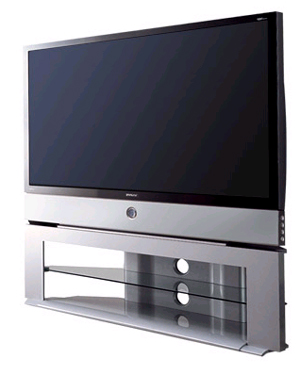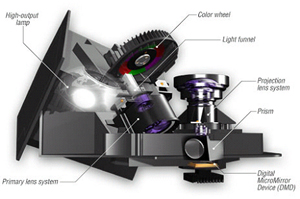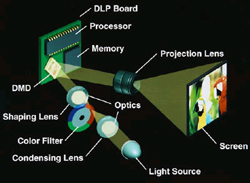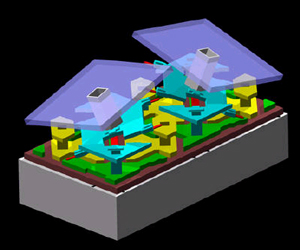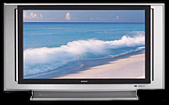2012 Mitsubishi Drops DLP Displays: Goodbye RPTVs Forever
|
DLP
(Display Light Processing) Format Texas Instruments developed the Digital Light Processing (DLP) in 1987, a display technology. DLP imaging systems employ either one or three large chip devices referred to as Digital Micro-mirror Devices, or DMD's, which is an optical semiconductor capable of steering photons with unparalleled accuracy, and the heart of the DLP projection system called the world's most sophisticated light switch. The DMD chip contains a unbelievable rectangular array of up to 1.3 million hinge-mounted microscopic mirrors; each of these micro-mirrors measuring less than one-fifth the width of a human hair and correspond to one pixel in a projected image. Micro-mirrors are mounted on the DMD chip and tilt in response to an electrical signal. The tilt directs light toward the screen, or into a "light trap" that eliminates unwanted light when reproducing blacks and shadows. The DMD and the sophisticated electronics that surround it are referred to as Digital Light Processing™ technology. A DMD panel's micro-mirrors are mounted on tiny hinges that enable them to tilt either toward the light source in a DLP™ projection system (ON), or away from it (OFF.)
This creates a light or dark pixel on the projection surface. A bit-streamed image code entering the semiconductor directs each mirror to switch On and Off up to several thousand times per second. If you are interested in how the DLP technology generates color with research provided by DVTCity, continue reading. If not, scroll down to move past this section on how the DLP technology works. ____________________________________ How It Works The concept is simple. When a mirror is switched on more frequently than off, it reflects a light gray pixel; a mirror that's switched off more frequently reflects a darker gray pixel. In this way, the mirrors in a DLP™ projection system can reflect pixels in up to 1,024 shades of gray to convert the video or graphic signal entering the DMD into a highly detailed grayscale image.
The white light generated by a lamp within the DLP™ projection system passes through a unique color wheel as the light travels to the surfaces of the DMD panel. The color wheel filters the light into equally-timed red, green, and blue flashes of light. A single-chip DLP™ projection system can create at least 16.7 million colors, not to mention the 3-DMD chip system found in huge commercial DLP Cinema™ projection systems amazingly capable of producing up to 35-trillion colors. The On-and-Off state of each Micro-mirror is coordinated with the three transmitted colors, red, green, and blue. For example, a mirror responsible for projecting the tertiary color purple pixel will only reflect red and blue light to the projection surface. The human eye then blends these three rapidly alternating flashes to see the intended single hue in the projected image.
A DLP-based HDTV television set should last indefinitely because the digital micro-mirrors are very stable with no maintenance or alignment required for DLP-based sets as they age. It's reported that devices have been tested for more than 1-trillion cycles, which is equivalent to 20 years of operation. Inspection of the devices after these tests showed no broken hinges on any of the devices. (Don't you wish hardware you had bought at the Home Depot or Loews would last as long?) The only consumer replaceable component is the DLP light source (a lamp) designed to last for about 8,000 hours and costs around $250. Finally, the micro-mirrors used in DLP are not subject to degradation due to heat, humidity, vibration or "burn-in" from an image that stays on the screen. Based on thousands of hours of life and environmental testing, the DMD and DLP systems exhibit inherent reliability. Because the DMD (Digital Micro Device) is a reflective device, it has a light efficiency greater than 60%, making DLP™ systems more efficient than LCD projection displays. This efficiency is the product of reflectivity; fill factor, diffraction-efficiency, and actual mirror "On" time. In contrast, LCD/TV's are polarization-dependent, so one of the polarized light components is not used, meaning that 50% of the lamplight never reaches the LCD, filtered out by a polarizer. Additional light is also blocked by the other LCD components built into the screen. In addition to these light losses, the liquid crystal material itself even absorbs a portion of the light. The result is that only a small amount of the original light is transmitted through the LCD panel and onto the screen for the viewer to watch. Again, the LCD's performance is limited because of its format's dependence on polarized light.
The square mirrors on DMD's are almost microscopic, 16 µm² across each separated by 1 µm gaps providing a fill factor of up to 90%. In other words, 90% of the pixel/mirror area can actively reflect light to create the projected image. Pixel size and gap uniformity are maintained over the entire array and are independent of resolution. This gives the DMD™ a high fill factor providing a more detailed perceived image resulting in better resolution. Combined with progressive scanning, this creates a projected image that is much more natural and film-like than conventional projection displays. Unlike the DMD™, LCD/TV's have only a best fill factor of 70%. Resolution standards that can be expected for computer display compatibility are as follows:
____________________________________
And again, as I say with all HDTV projection sets that are not CRT's, check out what audio, if any, comes with the set and if you will need to buy a supplemental audio system to create the reality in sound you are looking for to go with the larger picture. It could add $800 or more to the price of your purchase. In addition, check out the all-important jack-pack to see what kind and how many inputs and outputs you have available to you when you get home. And also be sure the unit comes with its own cable-ready tuner or HDTV tuner, if that is what you need. If it doesn't you'll have to purchase that, too. Plus, also read the warning below*. And if you didn't read how the DLP technology works, you'll need to eventually replace the $250 lamp that provides the light for the DLP format by yourself, which is said to be designed to last for about 8,000 hours, or about every three years if you watch your HDTV set seven hours a day. However, I have not seen any comments concerning this lamp's loss of pure white, the Plasma set maybe running into a white-balancing problem as the lamp ages. It's hard to believe that all sets use the same manufactured lamp source, so that's your only homework assignment if you are interested in purchasing a DLP HDTV television set. Again, and in a later chapter, you will see a graphic of my Sony's jack-pack that is just simply amazing, my using all but two of the inputs. Finally, because of the better picture quality of the new 1080p technology over 1080i, DLP is expected to rapidly grow in popularity after 2006.
New SXRD Format from Sony
___________________________________ ___________________________________
|
|
Index
|
